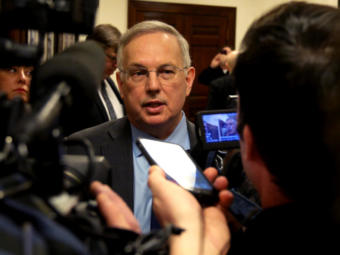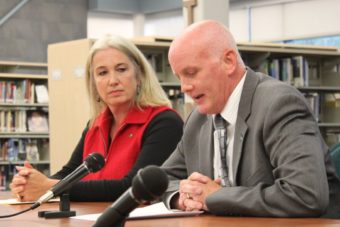
With Alaska facing a billion-dollar budget deficit and a nearly-empty primary savings account, James Kaufman’s pitch sounded compelling: We can have better government for less money — or at least the same amount.
“As soon as you talk about a cost reduction, immediately people say, ‘Well, that equals slashing services,’ and all these overheated terms get used,” Kaufman, a Republican running for a South Anchorage state House seat, said at a debate last week. “I think there’s room in all of these systems to find way to do a better job of delivering, and with that, find a way to reduce or hold costs. That’s going to have to happen as we go into this funding problem that we’re going to have to crack.”
Kaufman isn’t the only candidate with this point of view. Robb Myers, a Fairbanks Republican running for state Senate, said he thinks the state could cut as much as one-fourth of its $1.3 billion public schools budget without meaningful reductions in quality that Alaskans would reject.
“We can still have our budget and have the services that we expect at a much lower rate, without really compromising quality, in most cases,” he said in an interview.
But veterans of state budget battles say that after years of spending cuts, it’s unlikely that further reductions can fill much of the deficit without major impacts to services like schools and the Medicaid system.
Those two programs together cost the state $2 billion a year. And if lawmakers decide to boost the Permanent Fund dividend to the level set by a historical legal formula, as Myer is proposing, they could eliminate every single other state agency — Fish and Game, Corrections and Transportation — and still face a budget gap.
“The easy choices are gone,” said House Speaker Bryce Edgmon, I-Dillingham, who’s served in the Legislature since 2006. “When I hear candidates casually talk about what they’re going to do to make ends meet down in Juneau as if the choices are very easy at hand, I have to shudder — because I don’t think they know what they’re talking about.”

For candidates seeking to cut Alaska’s budget, the level of spending on schools and Medicaid make those the two most obvious options to reduce.
Myers said he sees inefficiencies in the state’s complicated “foundation formula” used to decide how much money flows to each public school. The formula sets aside more money for each student in smaller schools, which makes sense in rural areas, but discourages consolidation in urban areas, Myers said.
He described that as a “seriously perverse incentive” that pushes school districts to spend more money that doesn’t make it into the classroom.
Administrators say that while consolidation of urban schools can save money on maintenance, it can also boost the cost and complexity of busing and run into problems with overcrowding. And while they acknowledge that there might be some tweaks to Alaska’s schools spending formula that could save small amounts of cash, they argue that it’s unlikely that thrifty lawmakers have been overlooking obvious money-saving reforms.
The state Legislature has been trying to reduce the state budget since 2014, when there was a crash in oil revenues, which once paid the vast majority of Alaska’s bills.
“What are we now, four, five, six years into this?” asked Mike Hanley, superintendent of two rural Alaska school districts and a former state education commissioner. “You’re not going to find a piece of that formula that says ‘Oh, click, look at that — millions of dollars.’”

Hanley said that targeting the complicated schools spending formula is a way for politicians to talk around a more transparent and realistic way of cutting the schools budget: simply reducing the amount of money set aside for each student.
But cutting that line item, known as the base student allocation, faces a different obstacle in the form of a constitutional requirement that the state maintain a system of schools open to all children. Education advocates have already sued over that requirement once, winning an $18 million settlement in 2012 after a judge found that the state had failed to provide enough support and oversight for chronically underperforming schools.
“I think if somebody were to go in and challenge the size of that funding formula, we will definitely see a challenge,” Hanley said. “Because I don’t think it’s hard to argue that school districts have lost ground in the course of the last several years.”
The $650 million that the state spends on Medicaid is also not easily reduced.
Lawmakers already passed a bipartisan, money-saving Medicaid reform package in 2016.
And the Legislature cannot just simply cut the budget for Medicaid, because spending is guided not by how much money is set aside for the program but by eligibility standards, the types of services offered and the amount that hospitals and providers are paid for care.
Changing those elements can require adjustments to state law and regulation, and negotiation with the federal agency that pays for a large portion of the program.
“The state of Alaska is in a contract with the federal government for Medicaid benefits, and it can’t break that contract. That’s why they can’t just cut funding to Medicaid,” said D.J. Wilson, who runs a health policy organization called State of Reform.
Lawmakers could save money on Medicaid by voting to make fewer people eligible for the program, shrinking the type of benefits available to recipients and further cutting payments to providers, which the state has already reduced in recent years, Wilson said.
Alaska could also cut costs by moving away from a system that compensates providers for each service, regardless of how successful it was, and toward a more coordinated and strategic system of care that rewards efficiency, he said. But, Wilson added, “none of this is easy.”
“It is super complex, and no state has figured it out yet,” he said.
Even some Republican leaders acknowledge the challenges that come with cutting Medicaid spending.
“This is going to be a very difficult year coming up,” Wasilla Republican David Wilson, the chair of the Senate’s health committee, said at a conference hosted by Wilson’s group last month. “States, we don’t really have many options to help constrain the Medicaid spending.”